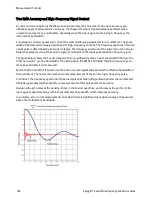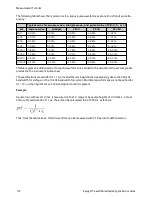
Minimizing Power Dissipation Effects
When measuring resistors designed for temperature measurements (or other resistive devices with large
temperature coefficients), be aware that the multimeter will dissipate some power in the DUT. The fol-
lowing table shows several examples.
Range Standard Test Current Power Dissipation in DUT
1 GΩ
500 nA
2.5 µW
100 MΩ 500 nA
2.5 µW
10 MΩ
500 nA
2.5 µW
1 MΩ
5 µA
25 µW
100 kΩ 10 µA
10 µW
10 kΩ
100 µA
100 µW
1 kΩ
1 mA
1 mW
100 Ω
1 mA
100 µW
If power dissipation is a problem, you should select a higher fixed range (all multimeter models) or, for the
34465A/70A, select the low power resistance measurement mode (see
(front panel), or
[SENSe:]{RESistance|FRESistance}:POWer:LIMit[:STATe
] (remote). The low power mode sources less test
current per measurement range than is normally sourced for standard resistance measurements, to
reduce power dissipation and self-heating in the DUT. The following table shows the various resistance
ranges, the standard test current delivered for 2- and 4-wire resistance measurements, and the low power
mode test current.
Range Standard Test Current Low Power Mode Test Current
1 GΩ
500 nA
500 nA
100 MΩ 500 nA
500 nA
10 MΩ
500 nA
500 nA
1 MΩ
5 µA
5 µA
100 kΩ 10 µA
5 µA
10 kΩ
100 µA
10 µA
1 kΩ
1 mA
100 µA
100 Ω
1 mA
100 µA
Errors in High Resistance Measurements
When you are measuring large resistances, significant errors can occur due to insulation resistance and sur-
face cleanliness. You should take the necessary precautions to maintain a "clean" high–resistance system.
Test leads and fixtures are susceptible to leakage due to moisture absorption in insulating materials and
"dirty" surface films. Nylon and PVC are relatively poor insulators (10
9
Ω) when compared to PTFE insu-
lators (10
13
Ω). Leakage from nylon or PVC insulators can easily contribute a 0.1% error when measuring a
1 MΩ resistance in humid conditions.
Measurement Tutorial
166
Keysight True
volt
Series Operating and Service Guide






























